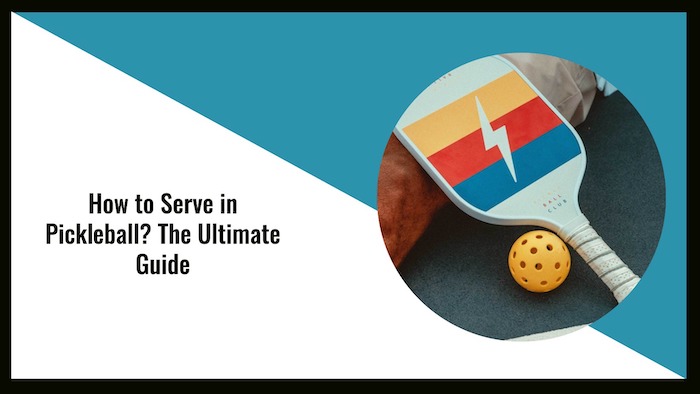Pickleball is a fun and easy sport that combines elements of tennis, badminton and ping-pong. It can be played indoors or outdoors, by singles or doubles, and by people of all ages and skill levels. But what makes pickleball different from other racket sports is the serve and how to serve in pickleball.
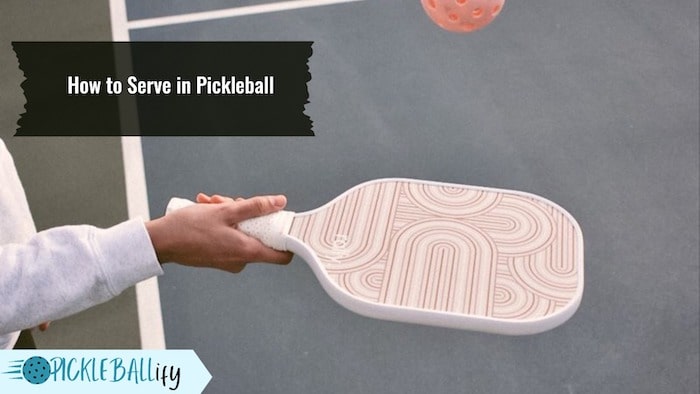
In this article, we will explain the basic rules of serving in pickleball, how to grip the paddle and position your body for a good serve, the different types of serves and when to use them, common serving mistakes and how to avoid them, and tips and drills to improve your serve.
What is Pickleball and Why is Serving Important?
Pickleball was founded in 1965 on Bainbridge Island, Washington, by three fathers looking for a way to entertain their bored children. A badminton court, a tennis net, ping-pong paddles, and a plastic ball with holes were employed. The game quickly spread among their friends and neighbours, and it eventually expanded throughout the country and around the world.

Pickleball is played on a 20-by-44-foot court, which is the same size as a doubles badminton court. The net measures 36 inches tall on the sidelines and 34 inches tall in the centre. On either side of the net, there are two service courts and a 7-foot non-volley zone (commonly known as the kitchen).
One of the most crucial components of pickleball is the serve, which initiates every rally and decides who has the edge. A solid serve may put your opponent under pressure, set up your next stroke, or perhaps immediately score a point. A faulty serve might set up an easy return for your opponent, put you on the defensive, or even cost you a point.
The Basic Rules of Serving in Pickleball
The rules of serving in pickleball are simple but strict. Here are some of the main rules you need to know:
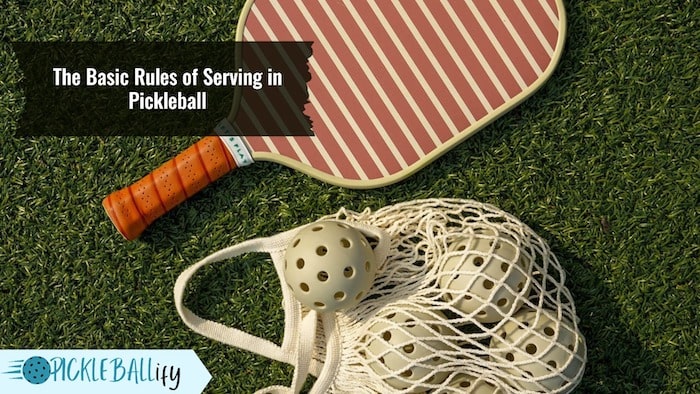
- You must serve underhand, with your paddle below your waist and your arm moving in an upward arc.
- You must hit the ball before it bounces on the ground.
- You must serve from behind the baseline and within the imaginary extension of the sideline.
- You must serve diagonally across the court into the opposite service court.
- You must clear the net and land within the boundaries of the court.
- You only get one serve attempt per point (unless it is a let serve, which means the ball touches the net but still lands in the correct service court).
- You must alternate serving with your partner if you are playing doubles.
- You must serve from the right service court when your score is even and from the left service court when your score is odd.
- You must announce your score and your opponent’s score before each serve.
How to Grip the Paddle for a Good Serve
The way you grip your paddle and position your body can have a big impact on your serve. Here are some tips to help you get ready for a good serve:
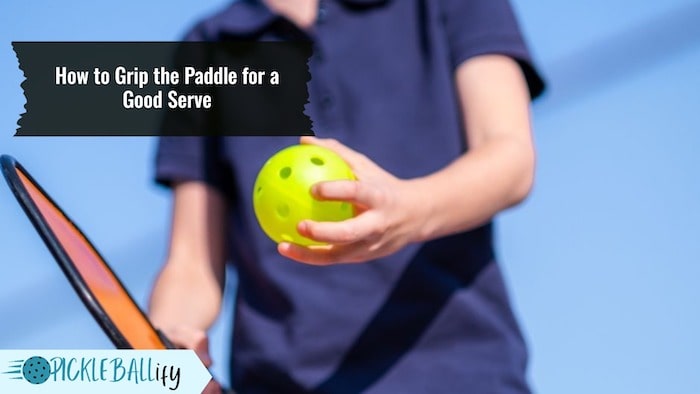
- Hold your paddle with a continental grip, which means placing your hand on the handle as if you were shaking hands with it. This grip allows you to hit both forehand and backhand serves with ease.
- Stand sideways to the net, with your feet shoulder-width apart and your weight on your back foot. This stance gives you balance and power for your serve.
- Hold your paddle in front of you with your arm slightly bent and relaxed. Keep your eye on the ball as you toss it slightly in front of you and above your waist.
- Swing your paddle from low to high in an upward arc, brushing under the ball to create spin and control. Snap your wrist at contact to generate speed and follow through with your arm across your body.
Different Types of Serves and When to Use Them
There are many types of serves you can use in pickleball, depending on your skill level, style of play, and strategy. Here are some of the most common ones.
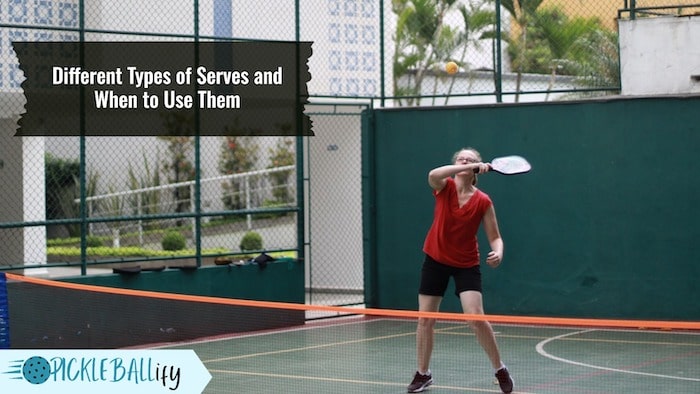
1) The basic serve: This is a simple but effective serve that aims to clear the net and land deep in the service court. It can be hit with little or no spin. This serve is good for beginners or when you want to play it safe.
2) The topspin serve: This is a more advanced serve that adds topspin to the ball, making it dip faster and bounce higher and harder. You can hit with a more upward and forward swing. This serve is good for putting pressure on your opponent or forcing them to hit a weak return.
3) The slice serve: This is another advanced serve that adds sidespin to the ball, making it curve and skid on the court. It can be hit with either forehand or backhand, with a more sideways and downward swing. This service is good for creating angles and changing the direction of the ball.
4) The lob serve: This is a tricky serve that sends the ball high and deep over your opponent’s head, making them run back to the baseline. You can hit with either forehand or backhand, with a high and gentle toss and a soft swing. This serve is good for catching your opponent off guard, especially if they are playing close to the net or the kitchen line.
5) The drop serve: This is a new serve that was introduced in 2021 as an alternative to the traditional underhand serve. It allows you to drop the ball on the ground and hit it after it bounces once. It can be hit with any kind of spin or speed.
How to Avoid Common Serving Mistakes
Serving in pickleball can be challenging, especially when you are under pressure or facing a tough opponent. Here are some of the most common serving mistakes and how to avoid them:
Hitting the Ball Too Hard or Too Soft
Striking the ball too hard might cause it to go out of bounds or into the net, while hitting it too soft allows your opponent to easily attack. To avoid this mistake, focus on hitting the ball with a consistent and comfortable pace, and adjust your swing according to the distance and angle of the court.
Hitting the Ball Too High or Too Low
Hitting the ball too high will cause it to fly out of bounds or lose speed and spin, whereas hitting it too low will cause it to hit the net or bounce short. To prevent this error, aim to strike the ball at an appropriate height, which for most serves is slightly above your waist. Likewise, make certain that you toss the ball at the appropriate height and position for your swing.
Hitting the Ball Too Flat or Too Spinny
Striking the ball too flat may make it predictable and simple to return while hitting it too spinny can make it lose control and accuracy. To prevent this error, concentrate on striking the ball with a balanced amount of spin and power, and adjust your spin and placement according to your plan.
Hitting the Same Serve Every Time
Hitting the same serve every time might make you predictable and simple for your opponent to read, allowing them to anticipate and counter your serve. To prevent making this error, vary your serves by varying your speed, spin, direction, depth, and height.
Additionally, keep an eye out for your opponent’s strengths and weaknesses and adjust your serve appropriately.
Tips and Drills to Improve Serve
Serving in pickleball is a skill that requires practice and improvement. Here are some tips and drills to help you improve your serve:
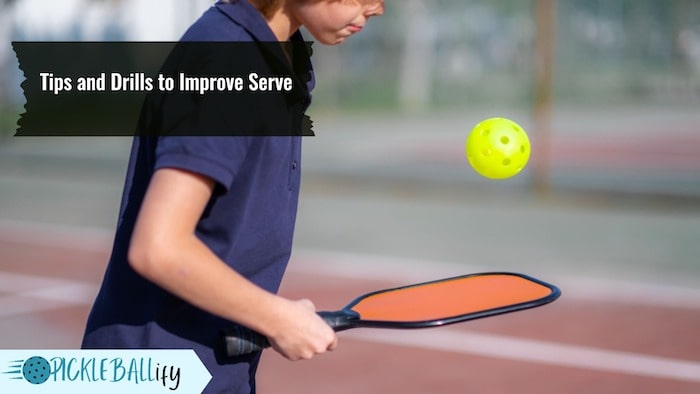
- Practice your serve regularly: The most effective strategy to enhance your serve is to practice it on a regular basis, especially with a partner or a coach who can provide feedback and instruction. You may also practice on your own by shooting at different objectives on the court with a basket of balls.
- Work on your technique: Your serve technique is critical to its efficacy and consistency. Working on your grip, stance, toss, swing, contact point, follow-through, and recovery is essential. You should also improve your mental game by remaining calm, confident, and focused while serving.
- Experiment with different serves: Experimenting with various serves can assist you in determining what works best for you and what challenges your opponent. You should experiment with several sorts of serves (basic, topspin, slice, lob, drop) and variants.
- Play games and matches: Playing games and tournaments may help you practice your serve in real-world settings and against a variety of opponents. You should experiment with different skill levels, styles, and methods to observe how people respond to your serve. Keep note of your serve statistics as well, such as %, points earned, mistakes, and aces.
FAQs
No, the serve must be underhand. This is a key difference between pickleball and tennis, where an overhead serve is allowed.
No, the server must stand behind the baseline and serve the ball diagonally to the opponent’s service court. They cannot step into the court before making contact with the ball.
If the ball hits the non-volley zone line during a serve, it’s considered a fault and the point goes to the opponent. The server gets another chance to serve, but if they make another fault, the point is lost.
No, faking out your opponent during a serve is considered a violation of the rules. The server must serve the ball after announcing the score and cannot try to deceive their opponent with their serve motion.
Conclusion
Pickleball is a fun and easy sport that anybody can play. It does, however, need skill and technique, particularly when it comes to serving. Serving in pickleball can give you an edge over your opponent, or it can cost you the point.
That’s why it’s critical to understand the fundamentals of serving, such as how to grip the paddle and position your body, the various types of serves and when to use them, common serving mistakes and how to avoid them, and serving tips and drills.
By following this method, you will be able to master the pickleball serve and take your game to the next level.

